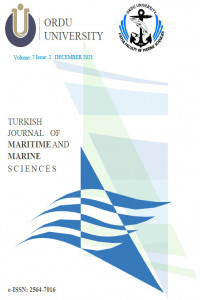Purification of Eicosapentaenoic Acid (EPA) and Docosahexaenoic Acid (DHA) From Fish Oil Using HPLC Method and Investigation of Their Antibacterial Effects on Some Pathogenic Bacteria
Purification of Eicosapentaenoic Acid (EPA) and Docosahexaenoic Acid (DHA) From Fish Oil Using HPLC Method and Investigation of Their Antibacterial Effects on Some Pathogenic Bacteria
High performance liquid chromatography (HPLC), docosahexaenoic acid (DHA), eicosapentaenoic acid (EPA), minimum inhibitory concentration (MIC),
___
- BAJPAIA, V.K., SHINA, S.Y., KIMB, H.R., KANGA, S.C., 2008. Anti-fungal action of bioconverted eicosapentaenoic acid (bEPA) against plant pathogens. Industrial Crops and Products 27, 136-141.
- CASTRO, I.A., TIRAPEGUIA, J., SILVA, R.S.S.F., CUTRIM, J.S., 2004. Sensory evaluation of a milk formulation supplemented with ω-3 polyunsaturated fatty acids and soluble fibres. Food Chem, 85 (4): 503 - 512.
- ECKEL, R.H., KRAUSS, R.M., 1998. American Heart Association Call to Action: Obesity as a Major Risk Factor for Coronary Heart Disease. Journal of The American Heart Association. 97:2099-2100.
- GIBNEY, M.J., 1997. Incorporation of ω-3 polyunsaturated fatty acids to processed food. British Journal of Nutrition, 78: 193 -195.
- GORDON, D.T., RATLIFF, V., 1992. The implications of omega-3 fatty acids in human healty, Advances in Seafood Biochemistry Composition and Quality, Ed. By George L. Flick, 406 pp. 69-98.
- HOSOKAWA, M., HOU, C.T., WEISLEDER, D., 2003. Bioconversion of ω-3 and ω-6 PUFA by Clavibacter sp. ALA2. Journal of the American Oil Chemists' Society 80, 1085–1091.
- HOU, C.T., 1995. Microbial oxidation of unsaturated fatty acids. In: Laskin, A.I. (Ed.), Advances in Applied Microbiology, vol. 41. Academic Press, Orlando, pp. 1–23.
- HOU, C.T., BAGBY, M.O., 1991. Production of a new compound, 7,10-dihydroxy- 8(E)-octadecenoic acid from oleic acid by Pseudomonas sp. PR3. Journal of Industrial Microbiology 7, 123–130.
- ICHIBARA, K., SHIBAHARA, A., YAMAMOTO, K. ve NAKAYAMA, T. 1996. An Improved Method for Rapid Analysis of The Fatty Acids of Glycerolipids, Lipids, 31: 535-539.
- KIM, H., GARDNER, H.W., HOU, C.T., 2000. Production of isomeric 9,10,13 (9,12,13)-trihydroxy-11E (10E)-octadecenoic acid from linoleic acid by Pseudomonas aeruginosa PR3. Journal of Industrial Microbiology and Biotechnology 25, 109–115.
- KOLANOWSKI, W., LAUFENBERG, G., 2006. Enrichment of food products with polyunsaturated fatty acids by fish oil addition. Europea Food Research Technology, 222: 472 - 477.
- KOLANOWSKI, W., SWIDERSKI, F., BERGER, S., 1999. Possibility of fish oil application for food products enrichment with omega-3 PUFA. International Journal of Food Science and Nutritions, 50: 39 - 49.
- KUO, T.M., KIM, H., HOU, C.T., 2001. Production of a novel compound, 7,10,12- trihydroxy-8(E)-octadecenoic acid from ricinoleic acid by Pseudomonas aeruginosa PR3. Current Microbiology 43, 198–203.
- KUO, T.M., MANTHEY, L.K., HOU, C.T., 1998. Fatty acid bioconversions by Pseudomonas aeruginosa PR3. Journal of the American Oil Chemists' Society 75, 875–879.LEAF, A., WEBER, P. C., 1988. Cardiovaskular effekts of n-3 fatty acids, N. Engl. J. Med., 318, 549-557.
- LOVEGROVE JA, BROOKS CN, MURPHY MC, GOULD BJ, WILLIAMS CM., 1997. Use of manufactured foods enriched with fish oils as a means of increasing long-chain n-3 polyunsaturated fatty acid intake. British Journal of Nutrition, 78: 223 - 236.
- MURRAY, P.R., BARON, E.J., PFALLER, M.A., TENOVER, F.C., YOLKE, R.H., 1995. Manual of Clinical Microbiology, 6th ed. ASM, Washington, DC.
- NIETO, S., CÓRDOBA, A.M., SANHUEZA, J., VALENZUELA, A., 1997. Obtention of highly purified fractions of eicosapentaenoic acid and docosahexaenoic acid from sardine oil by silver-resin chromatography: A semi-preparative procedure. Grasas y Aceites, 48, 197-199.
- PIGOTT, G.M., B.W. TUCKER., 1990. Seafood effects of technology on nutrition. Marcel Dekker, Inc. New York.
- SHIN, S.Y., BAJPAI, V.K., KIM, H.R., KANG, S.C., 2006. Antibacterial activity of bioconverted eicosapentaenoic (EPA) and docosahexaenoic acid (DHA) against food borne pathogenic bacteria. International Journal of Food Microbiology, 113, 233–236.
- TAUTWEIN, E.A., 2001. Omega-3 fatty acids-physiological and technical aspects for their use in food. European Journal of Lipid Science and Technology, 103:45-52.
- Yayın Aralığı: 4
- Başlangıç: 2015
- Yayıncı: ORDU ÜNİVERSİTESİ > FATSA DENİZ BİLİMLERİ FAKÜLTESİ
Deniz ve Liman İşletmeciliği Öğrencilerinin Liman Kavramına İlişkin Metaforik Algıları
Enes Fatih PEHLİVAN, İsmail ALTIN
Yılmaz UÇAR, Fatih ÖZOĞUL, Mustafa DURMUŞ, Yeşim ÖZOĞUL, Ali Rıza KÖŞKER, Esmeray KÜLEY BOĞA, Deniz AYAS
İzmir Körfezi’nde (Ege Denizi) Malta Palamudu Naucrates ductor (Carangidae)’un Bulunuşu
Yusuf Kenan BAYHAN, Deniz ERGÜDEN
Emtia Fiyatları İkinci El Değerler için Önemli midir? Capesize Piyasası Üzerine Bir Uygulama
Sadık Özlen BAŞER, Abdullah AÇIK
Zekiye BİRİNCİ ÖZDEMİR, Süleyman ÖZDEMİR, Uğur ÖZSANDIKÇI, Ferhat BÜYÜKDEVECİ, Berna BAYKAL
